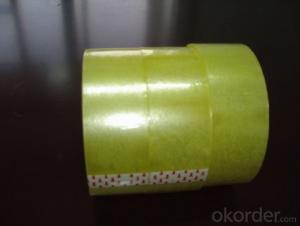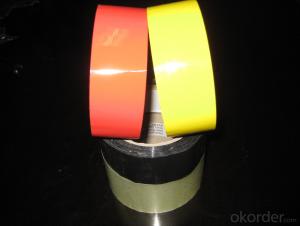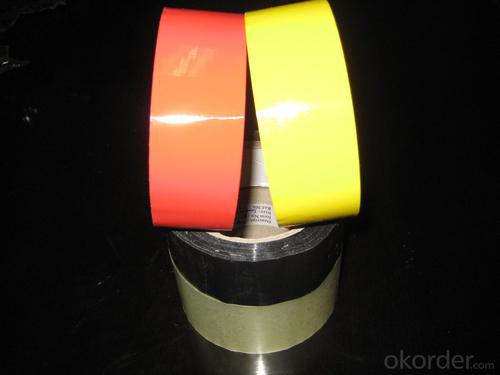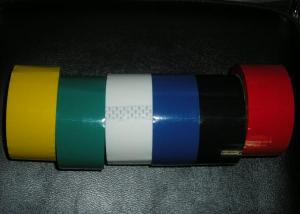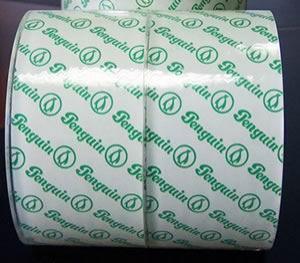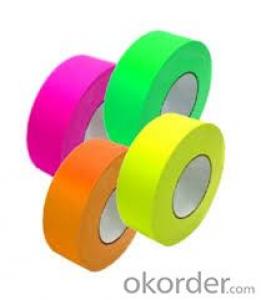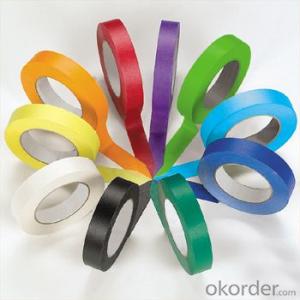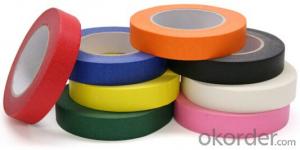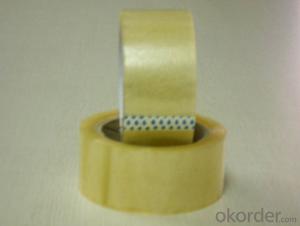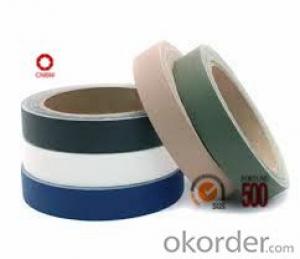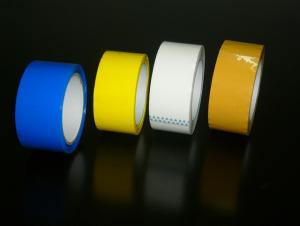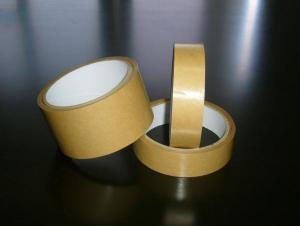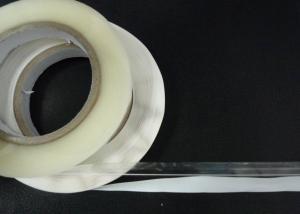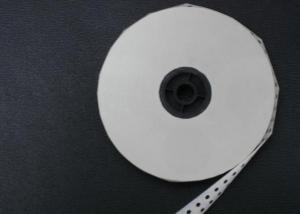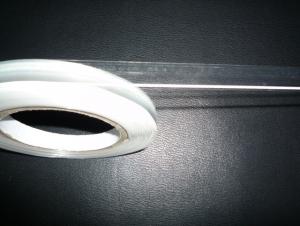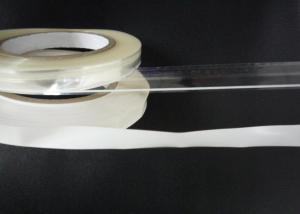3M Packaging Tape Philippines - Made in China 55 Micron
- Loading Port:
- China Main Port
- Payment Terms:
- TT OR LC
- Min Order Qty:
- -
- Supply Capability:
- -
OKorder Service Pledge
OKorder Financial Service
You Might Also Like
CONSTRUCTION:
Carrier: BOPP film
Adhesive: Water based acrylic adhesive.
TYPICAL PHYSICAL PROPERTIES:
Total Thickness (adhesives + carrier): 55 ± 2 um
Initial Tack (11mm steel ball): ³ 18#
180O Peel Adhesion (to steel): ³ 0.5 kgf /25mm
Holding Power: ³ 24 hrs
Tensile Strength: ³ 30 N/cm
Elongation: ≤180%
PACKING:
Core I.D.: 3” (76mm±1)
Jumbo Roll:1280mm x 4000m
Cut Roll: As per customer’s requirements
Application:
Carton sealing & packing, Light duty packaging, bundling, holding, and other office & household use.
REMARKS:
1. The data above are typical results and subject to change without notice.
2. Tolerance: Weight and Thickness: ±10%; Width: ±3mm;
Length: Cut Roll & Log Roll ±0.3m, Jumbo Roll ±0.5%.
3. The products should be stored at room temperature and be kept away wet and/or heat source.
4. It is essential, as with all pressure-sensitive tapes, that the surface to which the tape is applied must be clean, dry, and free of grease and oil.
5. The users should take test and do trial-application on the above products before coming into application so as to witness and ensure suitability for their special purpose and technique.
- Q: Does packaging tape come with a dispenser?
- Yes, packaging tape often comes with a dispenser. The purpose of the dispenser is to make it easier and more efficient to apply the tape to packages. The dispenser typically has a handle that allows you to hold and control the tape while sealing boxes or packages. This eliminates the need to cut the tape manually and prevents tangling or wasted tape. However, it's important to note that not all packaging tapes come with a dispenser. Some tapes may need to be purchased separately, while others may be sold as a set with the dispenser included. It is always a good idea to check the product description or packaging to confirm if a dispenser is included with the packaging tape.
- Q: Can packaging tape be used for sealing containers with liquids?
- Packaging tape is not suitable for sealing containers with liquids as it is not designed to provide a watertight seal. It may not be able to withstand the pressure or prevent leakage, leading to potential damage or spillage. It is recommended to use appropriate sealing methods such as specialized caps, lids, or seals specifically designed for liquid containers.
- Q: Is packaging tape suitable for sealing heavy boxes?
- Yes, packaging tape is suitable for sealing heavy boxes. Packaging tape is designed to provide a strong and secure seal for boxes of various sizes and weights. It is made from durable materials such as polypropylene or reinforced paper, which adds strength to the tape and ensures that it can handle the weight and pressure of heavy boxes. Additionally, packaging tape usually has a strong adhesive that bonds well with cardboard surfaces, ensuring a tight seal that can withstand the rigors of transportation and handling. However, it is recommended to use multiple strips of tape to reinforce the seal on heavy boxes for added security.
- Q: What are the considerations for using packaging tape on plastic or polyethylene bags?
- There are several factors to consider when using packaging tape on plastic or polyethylene bags. To begin with, it is crucial to choose the appropriate type of packaging tape for these surfaces. Certain tapes may not adhere well to plastic or polyethylene, resulting in poor adhesion and easy peeling. It is advisable to opt for tapes specifically designed for these materials, as they are typically formulated with adhesive that adheres properly. Another factor to take into account is the tape's strength and durability. Plastic bags are often lightweight and flexible, so it is important to select a tape that can provide sufficient strength to secure the bag's contents. Look for tapes with a strong adhesive backing that are resistant to tearing or stretching. Consideration should also be given to temperature and environmental conditions. Extreme temperatures can impact the tape's adhesive properties, leading to decreased adhesion or brittleness. If the bags will be exposed to high or low temperatures, it is recommended to choose a tape specifically designed for those conditions. Furthermore, it is essential to ensure that the tape does not cause any damage to the plastic or polyethylene bags. Some tapes may have strong adhesives that leave residue or cause harm when removed. Look for tapes labeled as having low residue, easy removal, or being safe for use on these surfaces. Lastly, aesthetics and presentation should be considered. Packaging tape is available in various colors and designs, allowing you to choose a tape that complements the bag's appearance or branding. It is important to make sure that the tape does not obstruct any important information or barcodes on the bag. In conclusion, when using packaging tape on plastic or polyethylene bags, it is important to consider selecting the right tape, ensuring strength and durability, taking into account temperature and environmental conditions, preventing damage to the bags, and considering aesthetics and presentation.
- Q: Can packaging tape be used for sealing packages with jewelry or valuables?
- Yes, packaging tape can be used for sealing packages containing jewelry or valuables. It provides a secure and reliable seal, ensuring that the contents of the package are protected during transit.
- Q: How does packaging tape perform on porous surfaces?
- When it comes to porous surfaces, packaging tape shows decent performance, even though its adhesive strength might be slightly compromised compared to non-porous surfaces. This tape is specifically designed to stick to a variety of surfaces such as cardboard, paper, and fabric, all of which are commonly known as porous materials. However, because these surfaces are porous, some of the adhesive may seep into the material, resulting in a reduction in bond strength. Moreover, the tape may not stick as firmly to porous surfaces, which makes it more likely to peel or lift. To ensure maximum adhesion, it is recommended to make sure the surface is clean and dry before applying the tape.
- Q: Can packaging tape be used for securing cables or cords?
- Indeed, cables or cords can be secured using packaging tape. Although it may not be the optimal option, particularly for prolonged or demanding uses, packaging tape can temporarily fasten cables or cords. This can aid in preventing entanglement or obstruction, particularly during transportation or storage. Nevertheless, it is crucial to acknowledge that packaging tape is not specifically designed for cable management. Consequently, it may not offer the same level of resilience or versatility as specialized cable ties or straps. For enduring or heavy-duty cable management, it is advisable to utilize products explicitly created for that intent.
- Q: How does packaging tape compare to duct tape in terms of strength and durability?
- Packaging tape and duct tape display notable disparities in terms of strength and durability. Packaging tape primarily serves the purpose of sealing boxes and securing lightweight packages, rendering it appropriate for general household use or tasks that involve low levels of exertion. It typically possesses a lower tensile strength and may be more susceptible to tearing or breaking when exposed to substantial stress or weight. Conversely, duct tape possesses a well-established reputation for its remarkable strength and durability. It is precisely engineered to provide a sturdy and long-lasting grip, making it the preferred choice for demanding tasks and repairs requiring a robust adhesive. Duct tape is composed of a resilient woven fabric backing coated with a durable adhesive, resulting in a tape capable of enduring high levels of tension and resisting tearing or breaking even in extreme conditions. While packaging tape is designed for temporary applications, duct tape is commonly employed in more strenuous and enduring projects, such as mending or fortifying items, bundling heavy objects, or even constructing provisional structures. Its versatility and superior strength make it a dependable option in situations where durability and resilience are of paramount importance. To summarize, packaging tape and duct tape diverge in their intended uses and capabilities. Packaging tape is suitable for lightweight applications and the sealing of boxes, whereas duct tape excels in heavy-duty tasks and offers outstanding strength and durability.
- Q: Food packaging, sealing tape printing and product manufacturers inconsistent with the use of it?
- This generally does not affect how, but this is the image of manufacturers
- Q: What are the different adhesive options available for packaging tape?
- There are several adhesive options available for packaging tape, including acrylic, hot melt, and natural rubber. Acrylic adhesive provides a strong bond and is resistant to aging and UV light. Hot melt adhesive offers excellent initial tack and adhesion, making it suitable for challenging surfaces. Natural rubber adhesive provides a strong and secure bond, especially on difficult surfaces like recycled cardboard.
Send your message to us
3M Packaging Tape Philippines - Made in China 55 Micron
- Loading Port:
- China Main Port
- Payment Terms:
- TT OR LC
- Min Order Qty:
- -
- Supply Capability:
- -
OKorder Service Pledge
OKorder Financial Service
Similar products
Hot products
Hot Searches
